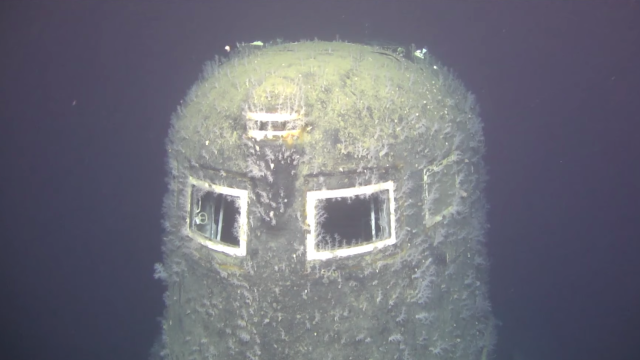Using a robotic sub, a team of investigators has detected traces of radiation leaking from Komsomolets – a Soviet nuclear submarine that sank 30 years ago in the Norwegian Sea. The recorded radiation levels are unusually high, but scientists say it’s not threatening humans or marine life.
On April 7, 1989, while cruising at a depth of 1250 feet, a fire broke out in the aft section of Komsomolets, a Soviet nuclear-powered attack submarine out on its first patrol. Its captain managed to bring the beleaguered sub to the surface, but it sank about five hours later.
All 42 sailors were killed in the incident, known as the Komsomolets disaster.
The 120 metre long nuclear submarine still rests some 1.7 kilometres below the surface of the Norwegian Sea, about 320 kilometres north of the Norwegian mainland.
And it’s leaking radiation, according to a press release issued by Norway’s Institute of Marine Research (IMR). The amount of cesium radiation leaking from the wreck is significant, at about 800,000 times the typical reading for the Norwegian Sea, but it “poses no risk to people or fish,” according to a collaborative research team involving IMR and the Norwegian Radiation and Nuclear Safety Authority (DSA).
Remote observations of Komsomolets have been made annually since the 1990s, but the most recent expedition, which ends this week, is the most thorough investigation of the wreck to date. Normally, scientists extract samples of water near the sub, but this time around the researchers deployed Aegir 6000, a remotely operated vehicle (ROV) that was dispatched and monitored from the research vessel G. O. Sars.
“We have been wanting to do a survey with an ROV for a number of years,” said expedition leader Hilde Elise Heldal in the press release. “Aegir 6000 allows us to see exactly where we are taking samples around the wreck, and equally importantly we’ve been able to use its cameras to zoom in and study the whole nuclear submarine section by section.”
Previous expeditions to the wreck by Russian teams documented radiation leaks around a ventilation duct, according to Heldal. Aegir 6000 was directed to the same spot, where it also detected high levels of radioactive cesium. So “we weren’t surprised to find high levels here,” she said.
By “high levels” the researchers are talking about levels 800,000 times higher than what’s typically observed in the Norwegian Sea. That said, not all samples taken near the vent produced the same high results, and measurements made just a few feet above the duct did not yield the same big levels of radioactivity, as Justin Gwynn, a researcher at DSA, explained in the press release.
A leaking radioactive sub certainly sounds scary, but this research suggests the wreck is not currently endangering the Norwegian Sea and outlying areas. Normally, radiation levels in the Norwegian Sea are at 0.001 Becquerel (Bq) per litre. Around the wreck, however, they are as high as 100 Bq per litre. For reference, the acceptable amount of radiation in food is 600 Bq per kilogram, as established by the Norwegian government in the wake of the Chernobyl disaster.
“The levels we detected were clearly above what is normal in the oceans, but they weren’t alarmingly high,” said Heldal. She also added that the wreck is quite deep and the radiation is diluting quickly. And there aren’t many fish in this part of the ocean, so there’s little danger of contaminating Norwegian seafood, Heldal said.
Aegir 6000 also detected puffs of murky water rising up from the duct and a nearby grill. This attracted the attention of the researchers, who are left wondering if it’s somehow related to the radioactivity. These “clouds,” as they called them, are worth investigating in the future.
The undersea probe also took samples of seawater, sediment, and tiny organisms attached to the wreck. These samples will be analysed in the lab, so the current results should be considered preliminary until that’s done.
This news comes just over a week after another Russian sub experienced a similar calamity. In the latest incident, a fire aboard a Russian navy “research” submarine killed 14 sailors. The fire was extinguished, and the vessel is now stationed at Severomorsk, according to the BBC.
